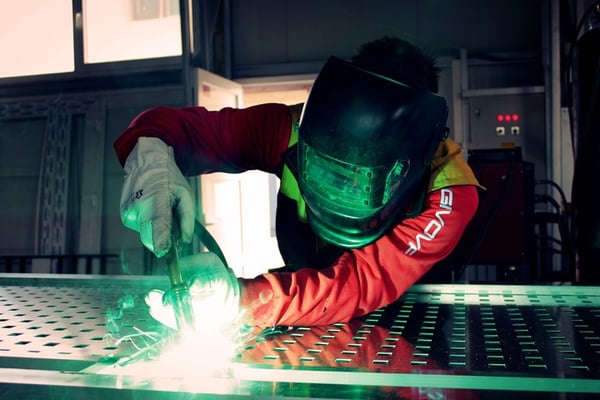Aluminum: love it or hate it, but you will have to work with it often and increasingly more often if you work with marine fabrication.
If you haven’t jumped on the Aluminum boat (figuratively speaking) you must read How to Make Aluminum a Fabricator’s Secret Weapon.
To summarize, aluminum is a sensitive material offering three amazing properties for those who learn the tricks to mastering it:
- Aluminum is naturally corrosion-resistant
- Aluminum’s strength-to-weight ratio is incredible
- Aluminum’s electrical conductivity is comparable to that of gold, silver, and copper
To produce at optimum levels, a fabricator must keep these two critical elements at the forefront when using aluminum and its alloys:
- Understand aluminum’s properties, like high conductivity and a low melting point
- Implement the right methods and best tools, such as proper grinding wheels

3 Surprising Aluminum Fabrication Success Tips
It’s not all about aluminum’s properties. Creating a sustainable system to support aluminum fabrication means taking your management techniques and business smarts to the next level. See how these three tips can revolutionize your aluminum fabrication process and the way you run your production team.
1. Train and give advancement opportunities more often than you’d think
In this 2013 article by Manufacturing.Net about the shrinking pool of skilled laborers in manufacturing they note two factors make or break younger employees’ chances of sticking around: training and advancement opportunities.
How
- In this video from Inc. magazine CEO Jessica Mah explains her trick to keeping younger employees: smaller raises and advancement opportunities given more frequently, like once a quarter
- Trainings given more frequently along with opportunities for novel approaches to age-old manufacturing problems may be the solution to keeping younger workers around while simultaneously engaging them longer term and increasing their level of skill for the task at hand
Why
- You save time, money and headaches by using training time to better the skill levels of existing workers rather than giving new employee orientations ad nauseum
- Buy-in to the company long term produces a highly-skilled workforce that understands the quality standards of your company and improves morale, leading to higher productivity
It may seem like a time-drain, but this upfront investment in your workforce will keep your laborers on task, working more efficiently, and thanking you for the opportunity to keep working for you.
2. Develop Relationships with Your Suppliers
Know your suppliers, understand how to get the best out of your materials, and develop relationships that ensure you can get your materials sourced quickly when needed. Read these 7 Tips for Better Relationships with Suppliers for a detailed outline. The top three tips are here:
Provide clear sales estimates
This helps the suppliers to know how to better supply you and when to restock their own shelves, so to speak.
- Have a clear understanding of your market demands
- Understand trends in fabrication by season and other predictive factors
Know Their Needs
It sounds counterintuitive. Yes, you are paying them to provide the materials, but this is more than an exchange of money for goods. You need to be on top of the documentation, invoices, and other items they may need from your company to keep their production and supply chain flowing smoothly to you.
Train Suppliers to Know Your Needs
Suppliers, in general, want to make your company satisfied. This keeps their revenue flowing and return customers are a steady flow of revenue. This obviously benefits your company to expend fewer hours and less energy on procurement. Ask your suppliers and ye shall receive:
- Can we order in smaller (or larger) quantities?
- Can you let us know when new specs are available?
Asking the right questions, being genuinely nice, and getting your suppliers to anticipate your needs can lead to fewer hours trying to make sure you’re covered and more time keeping your projects on time and on budget.
3. Be Nit-Picky About the Technical Details
Whoever said it’s the journey, not the destination was onto something. We’re not suggesting your ignore the final product. In fact, the best way to make sure that your final product is flawless is to take care of the small details along the way. Watch for these three common oversights to continue to deliver the level of service your clients have come to expect.

Feedability
Keeping your aluminum within the narrow speed and heat requirements for welding is critical to avoid burnthrough. Review best practices for GMAW processes The main properties of aluminum to mind are:
- Aluminum has a high level of thermal conductivity
- Aluminum is about 2.5 times less dense than steel
- Both of these make aluminum much more sensitive to small diversions from its welding best practices
Ensure that your team is trained on best practices for GMAW welding by reading these guidelines and learn to spot the errors for quick correction with this visual guide.
Porosity
Aluminum requires a gas shielding in order to protect the product and prevent unseemly craters.
Porosity can be the result of:
- An unshielded weld – either through a malfunction of the welding gun or wind blowing the shielding gas away
- Using a drag (not a push) technique with the welding gun – welders must remember to push (a 10-15 degree angle behind the imagined right angle created by the tip’s contact with the surface of the aluminum)
Again, the techniques here require training and reinforcement to ensure that your team knows the way to avoid welding defects like porosity.
Cracking
According to this AlcoTec article, craters happens at the end of a weld.
“If they are not filled in, they create a stress point, which can lead to cracking.”
The informative piece delves into further practical details in dealing with all three of the these common fabrication challenges. Pay attention to these small details in order to maintain a consistently quality finished product and a sense of pride and accomplishment within your shop.
The Obvious Truth
It’s no secret that paying attention to these three important tips will help your shop to function well, save time, save energy, and keep you on-budget. Review this article with your team to ensure that every person knows the tricks of working with aluminum fabrication processes.
Train your team well and often, pay attention to your supplier relationships, and get the devil out of the details with foolproof precision aluminum fabrication processes and your shop will come out on top.
Are you still looking for more information on aluminum?
